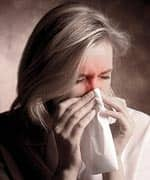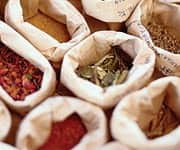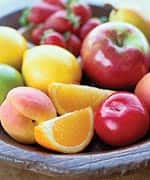Life Extension Magazine®
Consumers spend billions of dollars each year on over-the-counter cold and flu remedies, yet none of these drugs addresses the underlying factors that make people so susceptible to the viral infections that cause colds and flu. While over-the-counter drugs help treat cold symptoms, people remain sick until their bodies’ natural immune systems rally to overwhelm the infection. Healthy immune function is not only critical to rapid recovery from common viral infections, but also determines how resistant people are to contracting these illnesses. Further compounding the problem is that millions of doctors erroneously prescribe antibiotics to patients seeking relief for their cold symptoms. The inherent danger in this approach is that persistent misuse of antibiotics further weakens an already compromised immune system and may contribute to the development of antibiotic-resistant pathogens. When the immune system functions optimally, people are less likely to be infected by the countless bacteria and viruses to which they are exposed each day. In fact, proper immune function is essential to mounting an antibody response to the flu vaccine, which conventional doctors recommend to elderly patients to help protect against common strains of the influenza virus. Although Life Extension members achieve considerable immune support through their daily intake of high-potency antioxidants and hormones like DHEA, exciting new studies indicate that a combination of novel, natural agents works to strengthen critical immune components in the body, thus providing even greater protection against the onslaught of seasonal viral infections. Normal Aging Diminishes Immune FunctionImmune function declines precipitously with normal aging, as demonstrated by the large numbers of people over the age of 60 who succumb to influenza infections or suffer outbreaks of shingles (which occur when dormant herpes zoster viruses emerge due to depressed immune function).
Although considered “routine,” colds and flu can quickly lead to dangerous and even fatal upper-respiratory complications such as pneumonia. In 2002, influenza and pneumonia were the fifth leading cause of death among US men and women aged 65 and older, accounting for nearly 59,000 deaths in this age group alone. Among all ages and sexes, pneumonia and influenza were the seventh leading cause of death in 2002.1,2 Two years later, pneumonia and influenza slipped a notch, to the eighth leading cause of death among all Americans, supplanted by Alzheimer’s disease, which had formerly occupied that spot. Nevertheless, deaths from influenza and pneumonia still exceeded 61,000 in 2004.2,3 While the body’s age-related decline in immune function brings with it an increased susceptibility to infections,4,5 conventional medicine offers little to offset this decline. Despite mass immunizations of the elderly against influenza each year, lethal cases of flu and secondary pneumonia take a heavy toll on this age group. With advancing age, critical immune system cells called T-lymphocytes are less able to replicate, and their numbers diminish. Moreover, as these aging cells become “decrepit,” they may actually suppress immunity, further contributing to an aging person’s inability to fight off microscopic invaders.6,7 Immune function may also be weakened by factors ranging from chronic stress and poor nutrition to previous illnesses. When the immune system is compromised, a simple cold can quickly progress to full-blown pneumonia. This threat is especially significant for the elderly and is a leading cause of death for all Americans, regardless of age. Acquired Immunity vs. Innate ImmunityFor a large portion of the population, an annual flu shot may be the best defense against influenza infection. Flu shots work by exposing the immune system to very specific strains of flu virus that scientists believe are likely to cause an outbreak of flu in the coming year. After the body has been “primed” with specific (non-infective) viruses in the form of a vaccine, an optimally functioning immune system can then make antibodies that protect the body against future infection with these specific viruses. This ability to make antibodies in response to the flu vaccine is called acquired immunity. Acquired immunity is specific to the non-infective viruses contained within the vaccine. Thus, while it is highly effective against these particular viral strains, acquired immunity is of no value against the many other pathogens that people may encounter during cold and flu season. For this reason, the efficacy of a given vaccine is variable and usually limited.8,9
Fortunately, the body has a sophisticated primary defense system known as innate immunity. This system is designed to defend against all microbial invaders through the activation of large white blood cells called macrophages, which simply engulf their prey. However, their success depends on their ability to communicate effectively with other immune defense cells known as neutrophils, which make up most of the innate immune defense network. To neutralize an infection, it is critical that macrophages enlist the support of neutrophils in any battle against invading pathogens. Neutrophils are important types of white blood cells, critical for protecting your body against bacterial infection. Infection with the influenza type A virus has been found to deactivate neutrophils,10 which helps explain why people are at risk for bacterial illness during infection with the flu virus. Without the aid of neutrophils, the chances of succumbing to infection increase. Scientists have long known that macrophages must be “turned on” before they actively consume invaders ranging from bacteria and viruses to fungi and parasites. Immune-Boosting Power of Beta-GlucanActivating the communication and microbe-killing capabilities of macrophages is of paramount importance when confronting viral invaders, which may change their molecular “identities” in an effort to evade the body’s natural immune protection system. Numerous substances, including polysaccharides, lymphokines, and peptides, activate the defensive properties of macrophages. A polysaccharide called beta-glucan not only enhances macrophages’ ability to recognize and subdue microbial invaders, but also increases their ability to communicate with other cellular defenders of the immune system. These defenders, the immune “T cells,” subsequently initiate communications among a variety of immune system components, culminating in a cascade of events that amplify the immune response and ultimately overcome microbial invaders. Korean researchers have demonstrated a direct anti-viral effect of beta-glucan against the influenza virus. Scientists exposed two groups of newborn pigs to the swine flu virus. Capable of infecting humans, it was a type of swine flu that notoriously prompted the US government to attempt the first nationwide flu vaccination program 30 years ago. This dramatic effort was spurred in part by the realization that another strain of swine flu may well have been responsible for the global devastation of the great flu pandemic of 1918, in which millions of people perished. In this important experiment, one group of piglets received beta-glucan for three days before being infected with swine flu, while the other group received only a placebo for three days before infection with live virus. Objective evidence of swine flu infection in the lungs of piglets that had been infected, but not given beta-glucan, was significantly more severe than in the infected animals that had been pre-treated with beta-glucan.11 Furthermore, pigs that had been pre-treated with beta-glucan had significantly higher concentrations of natural disease-fighting substances, including interferon-gamma, in fluid obtained from the lungs within a week of infection. The researchers concluded that beta-glucan reduced signs of lung disease and the viral replication rate in the test subjects. These findings support the potential application of beta-glucan to prevent or treat influenza virus infection.11 In another experiment, scientists investigated the effects of beta-glucan against another viral challenge. Young piglets were exposed to porcine reproductive and respiratory syndrome virus, and then disease-fighting white blood cells were removed and exposed to varying concentrations of beta-glucan. Beta-glucan increased the production of interferon-gamma in a dose-dependent manner, leading the scientists to conclude that soluble beta-glucan may enhance innate antiviral immunity.12 These experiments demonstrate beta-glucan’s ability to dramatically improve innate immunity, particularly against potentially deadly viral infections.
While beta-glucan is found in several traditional folk remedies (including some Chinese mushrooms) that have been used for centuries to enhance immunity,13-16 these sources provide only limited amounts of the specific beta-glucan now known to provide powerful immune support. An old pharmaceutical preparation, Zymosan, was known to stimulate immunity as far back as the 1940s. Researchers at the Tulane University School of Medicine conducted dozens of studies of this substance, eventually isolating beta-glucan as its active ingredient. After the researchers modified this ingredient for ready ingestion, experimental evidence began to mount showing that beta-glucan is a highly effective immune system stimulator, activating defenses against both bacterial and viral organisms.17-21 Although beta-glucan is one of the most powerful biological response modifiers currently available in supplement form, not all beta-glucan supplements are created equal. As-yet-unpublished research, conducted at the University of Louisville in Kentucky, shows that a specially modified, yeast-derived form of beta-glucan dubbed beta-1,3-D-glucan is orally bioavailable and stimulates production of white blood cells in human bone marrow and spleen. Additionally, this proprietary form of beta-glucan has demonstrated superior ability to activate macrophages, neutrophils, and natural killer cells, effectively boosting immune function to confront threats ranging from radiation poisoning to tumors and infection.
| ||||||
Andrographis: Ancient Herb Repels InfectionsHumans have sought to prevent and treat infections for thousands of years. For example, healers in Asia and India have long prescribed the bitter herb Andrographis paniculata for the treatment of ailments ranging from infections and inflammation to colds and fevers.28 Modern science has finally taken note, and now researchers have isolated a number of the herb’s active ingredients. Chief among these are andrographolides, which are phytochemicals that are believed to exert their effects, in part, on tissues of the blood cell-producing bone marrow and/or spleen. Chinese researchers have discovered that one such compound, andrographanin, enhances the ability of certain white blood cells to recognize and neutralize foreign cells such as tumor cells and viruses.28 It is important to note that purified, concentrated bioactive andrographolides extracted from andrographis are far more potent, at considerably lower doses, than the crude herb alone. In animal and human clinical trials, Armenian scientists have demonstrated that andrographolides are readily absorbed into the bloodstream following the oral ingestion of andrographis herb extract. In Sweden, scientists conducted a randomized, double-blind, placebo-controlled study of standardized andrographis extract in the treatment of upper-respiratory tract infections (the common cold). More than 200 patients participated in the clinical trial. Symptoms were subjectively rated by patients and objectively rated by physicians during the course of treatment. These ratings (scores) covered symptoms such as muscle soreness, cough, throat pain, headache, elevated temperature, nasal symptoms, watery eyes, and swollen lymph glands. “Both the total symptom score and total diagnosis score showed highly significant improvement . . . in the [andrographis] group as compared with the placebo,” the researchers concluded. “In both studies, throat symptoms/signs were found to show the most significant improvement.”29 Russian researchers conducted a similar randomized trial of an andrographis extract preparation for the treatment of acute upper-respiratory viral infection. They concluded that the andrographis extract significantly relieved symptoms, “promoted cure,” and was well tolerated.30 The same scientists subsequently demonstrated that andrographis markedly reduced nasal secretions and nasal congestion among schoolchildren participating in a study of cold treatments. In this study, the andrographis extract was added to standard treatment and compared to another preparation containing the immune booster echinacea extract. Meta-Analyses Document Efficacy of AndrographisScientists in Thailand conducted a systematic review of the published literature and a meta-analysis of all randomized, controlled trials of andrographis for the symptomatic treatment of upper-respiratory tract infections. By pooling results from a number of disparate trials, they were able to arrive at an “overall estimate of effect.” The studies included in their statistical analysis featured results from 433 patients. Symptom severity scores were compared between control and test patients. Based on statistical analysis of those scores, andrographis was judged to be significantly more effective in relieving cold symptoms than placebo.31
In 2004, scientists at the universities of Exeter and Plymouth, in the United Kingdom, also published a review of controlled clinical trials of andrographis for the treatment of the common cold. They identified seven double-blind, controlled trials that met their rigorous criteria for inclusion. Data gathered from nearly 900 patients were included. “Collectively, the data suggest that A. paniculata [andrographis] is superior to placebo in alleviating the subjective symptoms of uncomplicated upper-respiratory tract infection,” the British scientists wrote. “There is also preliminary evidence of a preventive effect.” Furthermore, they noted that “adverse events” were generally mild and infrequent. Adverse events are documented during clinical trials in an effort to assess safety and tolerability of a given test substance or procedure. Based on these results, andrographis appears to be both effective and safe.32 New Studies Confirm Immune-Enhancing Effects of Vitamin CVitamin C has long been viewed as an immune system booster owing to its ability to strengthen vital components of the human immune system. For example, vitamin C has been shown to boost antimicrobial and natural killer cell activities, and to increase the production of white blood cells. In its role as a water-soluble antioxidant, vitamin C protects cells against reactive oxygen species generated during the respiratory burst (cellular energy production) and in the inflammatory response.33 In fact, vitamin C is essential for proper immune function.34 Because the human body cannot manufacture vitamin C, we are dependent on dietary intake to provide adequate amounts of this essential nutrient. Vitamin C concentrations decline rapidly in blood plasma and white blood cells during infections, suggesting that illness increases one’s need for this nutrient.35
Swiss scientists recently published a report emphasizing the crucial roles played by vitamin C and zinc, an essential element. “Both nutrients play important roles in immune function and the modulation of host resistance to infectious agents, reducing the risk, severity, and duration of infectious diseases,” wrote the researchers. “These trials document that adequate intakes of vitamin C and zinc ameliorate symptoms and shorten the duration of respiratory tract infections, including the common cold.”33 Researchers are now investigating new sources of vitamin C that may prove to be more bioavailable to the body. One extremely rich source of vitamin C is camu camu, a small fruit native to the Amazon rain forest. Scientists have demonstrated that camu camu contains 30 times more vitamin C than an orange. ConclusionWith winter just around the corner, millions of aging adults are gearing up to battle viral infections that can produce days and even weeks of coughing, sneezing, and other cold and flu symptoms. These infections can even induce potentially life-threatening complications such as pneumonia. Unfortunately, by the time cold and flu sufferers reach for over-the-counter medications, it is already too late to address the underlying factors that have diminished their bodily defenses against viral infections. Fortunately, emerging scientific research demonstrates that the combination of beta-glucan, andrographis, and natural vitamin C from camu camu provides powerful, synergistic immune system support, helping the body to naturally defend itself against the dreaded seasonal onslaught of cold and flu viruses. Unlike traditional medications that merely mask symptoms while offering nothing in the way of immune support, natural supplements like beta-glucan and andrographis boost immunity to help the body repel microbial invaders and thus prevent cold and flu viruses from gaining a foothold. This potent supplement can be taken as a prophylactic during cold and flu season, and may also be increased in dosage in the event of an infection, thereby further bolstering the body’s immune-fighting capabilities and assisting recovery. | |||
| References | |||
| 1. Anderson RN, Smith BL. Deaths: leading causes for 2002. Natl Vital Stat Rep. 2005 Mar 7;53(17):1-89. 2. Available at: http://www.cdc.gov/nchs/data/nvsr/nvsr53/nvsr53_17.pdf. Accessed September 6, 2006. 3. Minino AM, Heron MP, Smith BL. Deaths: preliminary data for 2004. Natl Vital Stat Rep. 2006 Jun 28;54(19):1-49. 4. van Baarle D, Tsegaye A, Miedema F, Akbar A. Significance of senescence for virus-specific memory T cell responses: rapid ageing during chronic stimulation of the immune system. Immunol Lett. 2005 Feb 15;97(1):19-29. 5. Deng Y, Jing Y, Campbell AE, Gravenstein S. Age-related impaired type 1 T cell responses to influenza: reduced activation ex vivo, decreased expansion in CTL culture in vitro, and blunted response to influenza vaccination in vivo in the elderly. J Immunol. 2004 Mar 15;172(6):3437-46. 6. Effros RB, Dagarag M, Spaudling C, Man J. The role of CD8+ T-cell replicative senescence in human aging. Immunol Rev. 2005 Jun;205:147-57. 7. Effros RB. Replicative senescence of CD8 T cells: effect on human ageing. Exp Gerontol. 2004 Apr;39(4):517-24. 8. Ferguson NM, Cummings DA, Fraser C, Cajka JC, Cooley PC, Burke DS. Strategies for mitigating an influenza pandemic. Nature. 2006 Jul 27;442(7101):448-52. Epub 2006 Apr 26. 9. Uphoff H, Hauri AM, Schweiger B, et al. [Estimation of influenza vaccine effectiveness using routine surveillance data] Bundesgesundheitsblatt Gesundheitsforschung Gesundheitsschutz. 2006 Mar;49(3):287-95. 10. Hartshorn KL, Reid KB, White MR, et al. Neutrophil deactivation by influenza A viruses: mechanisms of protection after viral opsonization with collectins and hemagglutination-inhibiting antibodies. Blood. 1996 Apr 15;87(8):3450-61. 11. Jung K, Ha Y, Ha SK, et al. Antiviral effect of Saccharomyces cerevisiae beta-glucan to swine influenza virus by increased production of interferon-gamma and nitric oxide. J Vet Med B Infect Dis Vet Public Health. 2004 Mar;51(2):72-6. 12. Xiao Z, Trincado CA, Murtaugh MP. Beta-glucan enhancement of T cell IFNgamma response in swine. Vet Immunol Immunopathol. 2004 Dec 8;102(3):315-20. 13. Wasser SP. Medicinal mushrooms as a source of antitumor and immunomodulating polysaccharides. Appl Microbiol Biotechnol. 2002 Nov;60(3):258-74. Epub 2002 Sep 10. 14. Hsieh TC, Kunicki J, Darzynkiewicz Z, Wu JM. Effects of extracts of Coriolus versicolor (I’m-Yunity) on cell-cycle progression and expression of interleukins-1 beta,-6, and -8 in promyelocytic HL-60 leukemic cells and mitogenically stimulated and nonstimulated human lymphocytes. J Altern Complement Med. 2002 Oct;8(5):591-602. 15. Kuo MC, Weng CY, Ha CL. Ganoderma lucidum mycelia enhance innate immunity by activating NF-kappaB. J Ethnopharmacol. 2006 Jan 16;103(2):217-22. 16. Lull C, Wichers HJ, Savelkoul HF. Antiinflammatory and immunomodulating properties of fungal metabolites. Mediators Inflamm. 2005 Jun 9;2005(2):63-80. 17. Di Luzio NR, Williams DL. Protective effect of glucan against systemic Staphylococcus aureus septicemia in normal and leukemic mice. Infect Immun. 1978 Jun;20(3):804-10. 18. Di Luzio NR, Williams DL, McNamee RB, Edwards BF, Kitahama A. Comparative tumor-inhibitory and anti-bacterial activity of soluble and particulate glucan. Int J Cancer. 1979 Dec 15;24(6):773-9. 19. Kokoshis PL, Williams DL, Cook JA, DiLuzio NR. Increased resistance to Staphylococcus aureus infection and enhancement in serum lysozyme activity by glucan. Science. 1978 Mar 24;199(4335):1340-2. 20. Reynolds JA, Kastello MD, Harrington DG, et al. Glucan-induced enhancement of host resistance to selected infectious diseases. Infect Immun. 1980 Oct;30(1):51-7. 21. Li J, Li DF, Xing JJ, Cheng ZB, Lai CH.. Effects of beta-glucan extracted from Saccharomyces cerevisiae on growth performance, and immunological and somatotropic responses of pigs challenged with Escherichia coli lipopolysaccharide. J Anim Sci. 2006 Sep;84(9):2374-81. 22. Gu YH, Takagi Y, Nakamura T, et al. Enhancement of radioprotection and anti-tumor immunity by yeast-derived beta-glucan in mice. J Med Food. 2005 Summer;8(2):154-8. 23. Hofer M, Pospisil M. Glucan as stimulator of hematopoiesis in normal and gamma-irradiated mice. A survey of the authors’ results. Int J Immunopharmacol. 1997 Sep-Oct;19(9-10):607-9. 24. Kournikakis B, Mandeville R, Brousseau P, Ostroff G. Anthrax-protective effects of yeast beta 1,3 glucans. MedGenMed. 2003 Mar 21;5(1):1. 25. Kernodle DS, Gates H, Kaiser AB. Prophylactic anti-infective activity of poly-[1-6]-beta-D-glucopyranosyl-[1-3]-beta-D-glucopryanose glucan in a guinea pig model of staphylococcal wound infection. Antimicrob Agents Chemother. 1998 Mar;42(3):545-9. 26. Onderdonk AB, Cisneros RL, Hinkson P, Ostroff G. Anti-infective effect of poly-beta 1-6-glucotriosyl-beta 1-3-glucopyranose glucan in vivo. Infect Immun. 1992 Apr;60(4):1642-7. 27. Hetland G, Lovik M, Wiker HG. Protective effect of beta-glucan against mycobacterium bovis, BCG infection in BALB/c mice. Scand J Immunol. 1998 Jun;47(6):548-53. 28. Ji LL, Wang Z, Dong F, Zhang WB, Wang ZT. Andrograpanin, a compound isolated from anti-inflammatory traditional Chinese medicine Andrographis paniculata, enhances chemokine SDF-1alpha-induced leukocytes chemotaxis. J Cell Biochem. 2005 Aug 1;95(5):970-8. 29. Melchior J, Spasov AA, Ostrovskij OV, Bulanov AE, Wikman G Double-blind, placebo-controlled pilot and phase III study of activity of standardized Andrographis paniculata Herba Nees extract fixed combination (Kan jang) in the treatment of uncomplicated upper-respiratory tract infection. Phytomedicine. 2000 Oct;7(5):341-50. 30. Shakhova EG, Spasov AA, Ostrovskii OV, Konovalova IV, Chernikov MV, Mel’nikova GI. [Effectiveness of using the drug Kan-Yang in children with acute respiratory viral infection (clinico-functional data)] Vestn Otorinolaringol. 2003;(3):48-50. 31. Poolsup N, Suthisisang C, Prathanturarug S, Asawamekin A, Chanchareon U. Andrographis paniculata in the symptomatic treatment of uncomplicated upper respiratory tract infection: systematic review of randomized controlled trials. J Clin Pharm Ther. 2004 Feb;29(1):37-45. 32. Coon JT, Ernst E. Andrographis paniculata in the treatment of upper respiratory tract infections: a systematic review of safety and efficacy. Planta Med. 2004 Apr;70(4):293-8. 33. Wintergerst ES, Maggini S, Hornig DH. Immune-enhancing role of vitamin C and zinc and effect on clinical conditions. Ann Nutr Metab. 2006;50(2):85-94. Epub 2005 Dec 21. 34. Calder PC, Kew S. The immune system: a target for functional foods? Br J Nutr. 2002 Nov;88 Suppl 2:S165-77. 35. Allard JP, Aghdassi E, Chau J, Salit I, Walmsley S. Oxidative stress and plasma antioxidant micronutrients in humans with HIV infection. Am J Clin Nutr. 1998 Jan;67(1):143-7. |







